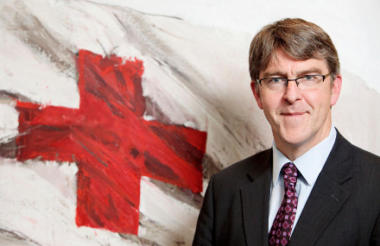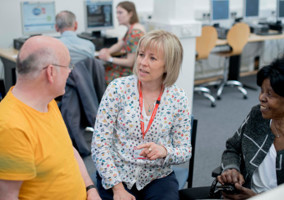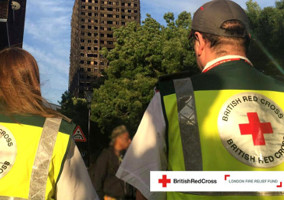The British Red Cross has an ambitious ten-year strategy. It wants to drill down and focus on three key areas where there is pressing and unmet need, and where it believes it will have the most impact.
But to do so it has had to make some difficult decisions about which services to withdraw from, it has to build new, more collaborative relationships with others in the sector and beyond, all under the shadow of diminishing resources, higher public expectations and the need to become more flexible.
Nevertheless, Mike Adamson, who has been chief executive since 2014, is confident that the charity's underpinning message about “the power of kindness” is relevant and valuable for 2020 and beyond.
Three areas of focus
Adamson says the charity has identified three areas that it will focus on, which are:
- People in emergencies.
- People who are displaced.
- People who are falling between the gaps in the health and social care system.
“The reason that we’re focusing on those three big causes is that we’ve taken a look at what’s going on in the world,” he says, adding that the charity has identified areas where it has particular expertise.
He highlights the well-documented challenges of the “ageing population”, the fact that there are “more people displaced in the world now than at any time since the Second World War”, and “health inequalities” in the UK, where life expectancy varies greatly depending on which part of the country you live in.
He says: “We want to try to bring some of the things that make us different and special in who we are to bear on those issues.”
In health and social care, the charity plans to focus on areas where there “overlapping risks”. For example, the British Red Cross’s work around loneliness can be combined with first aid work to help build more connected communities.
When it comes to issues around migration, the Red Cross is uniquely well-placed to offer support because there is either a Red Cross or Red Crescent Society in every country.
The charity is asking itself “How can we ensure that people on those trails get good practical help and information that will help them make good decisions about whether to continue on their journeys,” he says.
‘We can’t do it alone’
But the British Red Cross says it cannot fulfil its mission alone, so working more collaboratively with a range of other organisations is a key part of its new strategy, with the overarching aim of making the “whole system work better”.
“We’ve learned a huge amount from our experience at Grenfell,” he says, where the charity was instrumental in coordinating the response and support for survivors. However, despite this, “we also recognise that we weren't connected nearly well enough to a whole host of both national organisations and local community organisations”.
To that end, the British Red Cross has helped set up a Voluntary Community Sector Emergency Partnership, involving St John Ambulance, Victim Support, Muslim Aid, UK Community Foundations, NAVCA and NCVO as well as representatives from government departments and local authorities.
But working in genuine partnership with smaller organisations is not something that larger charities have always been good at.
Adamson believes the onus is on the Red Cross to treat those it works with respectfully and with “humility”.
“It’s about how we conduct ourselves as we reach out to other organisations that we think are important to the causes we are trying to address,” he says, adding that it is important to approach potential partnerships with “a high degree of humility” and “the curiosity to find out and get to people and the issues”.
It is not just about collaboration across the voluntary sector. Adamson is also looking to the private sector for potential partners, to secure access to additional resources but also to provide “other ways to doing things” and reaching people.
Pulling out of first aid at public events
The ambition to have a bigger impact in three core areas comes at a time when the British Red Cross, like a number of other large charities, has seen its finances come under pressure.
In the year to December 2018, the charity had a total income of £243m, but regular giving has fallen from around £50m in 2014 to £40m last year.
“General funds income of many charities is under real pressure,” he says, “and we’re no exception to that.”
This means that the British Red Cross has taken the difficult decision to withdraw from offering first aid services at live events.
The charity had been “trying to move that onto a social enterprise basis” but had been unable to reach a break-even point.
“It is a commercial market in which other people are making money,” Adamson says. “Indeed there are other charitable operators like St John Ambulance, so we can’t justify continuing to put funds into that, when those needs for first aid at a public event will still be met. In most of these other spaces we want to work there is no commercial market, and the market is failing.”
This is likely to lead to some redundancies. The charity has begun a consultation process, but hopes to be able to redeploy people.
Thinking long-term
Unlike previous strategic periods, which are typically three-to-five-years long, Adamson is talking about a decade-long programme.
“What we realised is that we need to think longer term because the issues we’re trying to tackle are enduring humanitarian issues,” Adamson says, “and we won’t find solutions to them in a three-to-five-year business-plan context.”
This longer-term thinking is also reflected in the charity’s approach to its supporters.
“We want to mobilise people around these causes,” he explains. “We want to transform our fundraising operation into a supporter-engagement operation.”
This means building a lasting relationship with people that might see them give money at some points but time at others.
So, unlike the traditional fundraising model which focuses on acquisition, the British Red Cross “will be about building that partnership and the retention of those people as supporters for the long term.”
Trustees are expected to formally sign off on the new strategy at the end of the year and are currently working through how success could be measured.
New ways of working
Adamson reveals an ambition to turn the British Red Cross into a greener, more diverse, more flexible organisation that is fit for the future.
He says the charity has an “ambition that we would be carbon neutral as an organisation by 2025”.
This is partly down to pressure from donors, who will rightly want the charities they support to hold themselves to high standards, but also because with a lot of the issues the Red Cross is trying to tackle, climate change is “behind the volatility”.
“So we ourselves need to live up to those green values in order to be credible,” he says. This means looking at how it can use fewer resources, and travel less through using technology, among other things.
He is also committed to “continuing the very significant progress we have made around becoming more inclusive and more diverse”.
Elsewhere, Adamson emphasises the importance of developing a more flexible workforce, as technology forces changes to workplaces over the next five years.
“The change in job titles and job descriptions over the coming three-to-five years is going to be enormous,” he says.
While he is confident there will continue to be “unmet need”, he is less confident about the skills needed to address it, which creates uncertainty about job roles.
“So what we need is people who are committed to Red Cross values and principles,” he says, adding that the charity needs to be prepared to “invest in their training and development” so the people are comfortable moving around teams and projects.
“We need people who will stay with us, but be ready to operate much more flexibly than we have needed to do in the past.”
The power of kindness
Adamson says that the thing which underpins its whole vision is humanity. “Actually our brand is around the power of kindness,” he says.
“Whether it’s about the consequences of Brexit, in terms of society becoming less tolerant, or about the way we respond to kindness to people in society or displays of kindness to people in emergency situations.
“The power of kindness is the underpinning value that we’re trying to mobilise.”
|
Related articles












